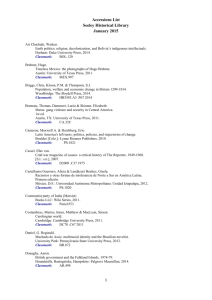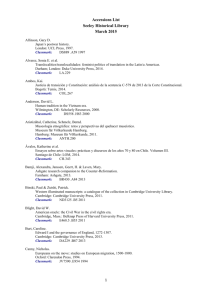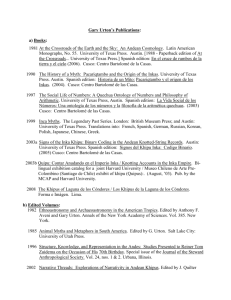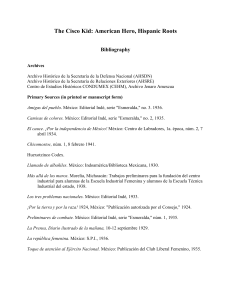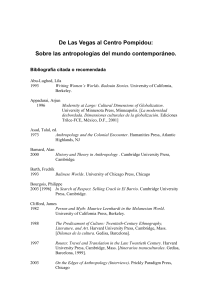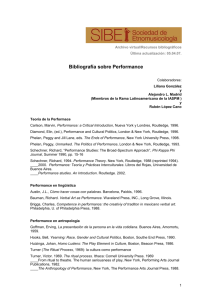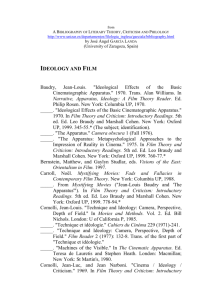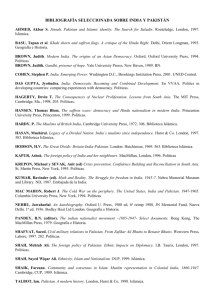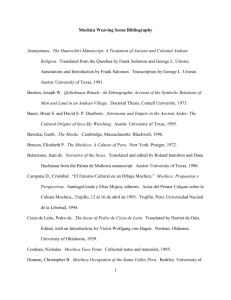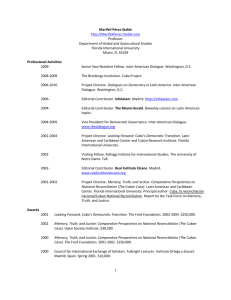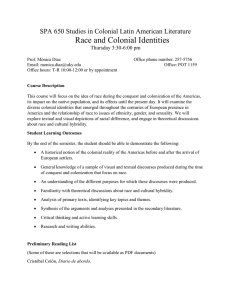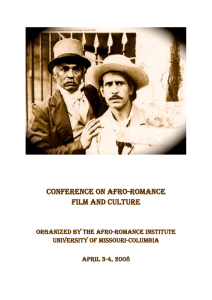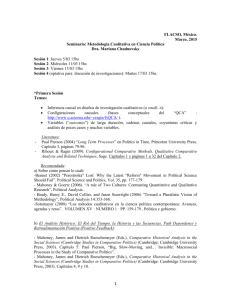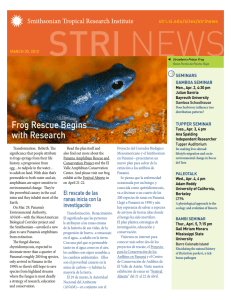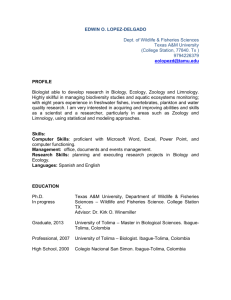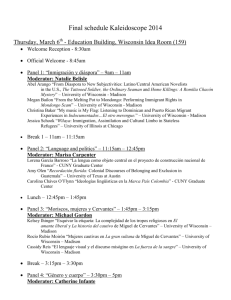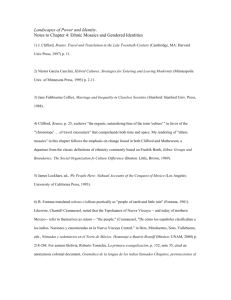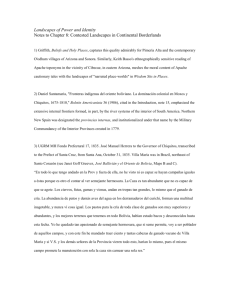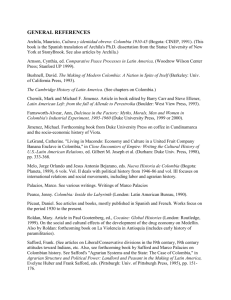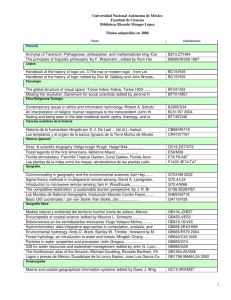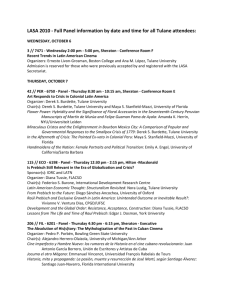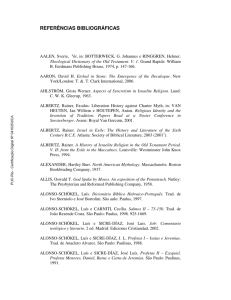IL1: Ethnographic Filmmaking from Argentina and Brazil
advertisement
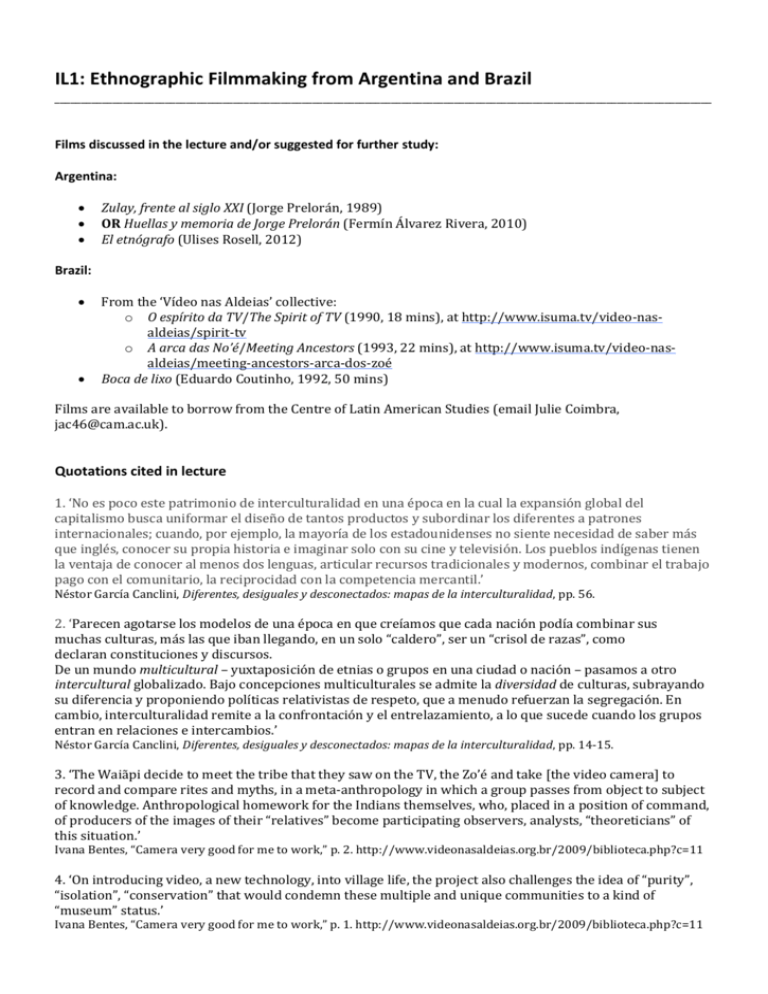
IL1: Ethnographic Filmmaking from Argentina and Brazil _____________________________________________________________________________________________________________________________ Films discussed in the lecture and/or suggested for further study: Argentina: Zulay, frente al siglo XXI (Jorge Prelorán, 1989) OR Huellas y memoria de Jorge Prelorán (Fermín Álvarez Rivera, 2010) El etnógrafo (Ulises Rosell, 2012) Brazil: From the ‘Vídeo nas Aldeias’ collective: o O espírito da TV/The Spirit of TV (1990, 18 mins), at http://www.isuma.tv/video-nasaldeias/spirit-tv o A arca das No’é/Meeting Ancestors (1993, 22 mins), at http://www.isuma.tv/video-nasaldeias/meeting-ancestors-arca-dos-zoé Boca de lixo (Eduardo Coutinho, 1992, 50 mins) Films are available to borrow from the Centre of Latin American Studies (email Julie Coimbra, jac46@cam.ac.uk). Quotations cited in lecture 1. ‘No es poco este patrimonio de interculturalidad en una época en la cual la expansión global del capitalismo busca uniformar el diseño de tantos productos y subordinar los diferentes a patrones internacionales; cuando, por ejemplo, la mayoría de los estadounidenses no siente necesidad de saber más que inglés, conocer su propia historia e imaginar solo con su cine y televisión. Los pueblos indígenas tienen la ventaja de conocer al menos dos lenguas, articular recursos tradicionales y modernos, combinar el trabajo pago con el comunitario, la reciprocidad con la competencia mercantil.’ Néstor García Canclini, Diferentes, desiguales y desconectados: mapas de la interculturalidad, pp. 56. 2. ‘Parecen agotarse los modelos de una época en que creíamos que cada nación podía combinar sus muchas culturas, más las que iban llegando, en un solo “caldero”, ser un “crisol de razas”, como declaran constituciones y discursos. De un mundo multicultural – yuxtaposición de etnias o grupos en una ciudad o nación – pasamos a otro intercultural globalizado. Bajo concepciones multiculturales se admite la diversidad de culturas, subrayando su diferencia y proponiendo políticas relativistas de respeto, que a menudo refuerzan la segregación. En cambio, interculturalidad remite a la confrontación y el entrelazamiento, a lo que sucede cuando los grupos entran en relaciones e intercambios.’ Néstor García Canclini, Diferentes, desiguales y desconectados: mapas de la interculturalidad, pp. 14-15. 3. ‘The Waiãpi decide to meet the tribe that they saw on the TV, the Zo’é and take [the video camera] to record and compare rites and myths, in a meta-anthropology in which a group passes from object to subject of knowledge. Anthropological homework for the Indians themselves, who, placed in a position of command, of producers of the images of their “relatives” become participating observers, analysts, “theoreticians” of this situation.’ Ivana Bentes, “Camera very good for me to work,” p. 2. http://www.videonasaldeias.org.br/2009/biblioteca.php?c=11 4. ‘On introducing video, a new technology, into village life, the project also challenges the idea of “purity”, “isolation”, “conservation” that would condemn these multiple and unique communities to a kind of “museum” status.’ Ivana Bentes, “Camera very good for me to work,” p. 1. http://www.videonasaldeias.org.br/2009/biblioteca.php?c=11 5. ‘Ethnographic film and video, which were once seen as reinforcing established cultural boundaries, are increasingly seen as part of a wider spectrum of cultural representations, much of which is devoted to the very problematics and contradictions of maintaining discrete, indigenous cultures.’ David MacDougall, Transcultural Cinema, p. 261. 6. ‘I think we are already seeing the changes in a new emphasis on authorship and specific cultural perspectives. Films are less often posed as omniscient or definitive descriptions […]. Societies are no longer portrayed as monolithic, or unpenetrated by external and historical forces. […] I think we will therefore see films which become repositories of multiple authorship, confrontation and exchange.’ David MacDougall, “Complicities of Style,” p. 97. Bibliography On ethnographic filmmaking Córdova, Amalia. “Reenact, Reimagine: Performative Indigenous Documentaries of Bolivia and Brazil.” In New Documentaries in Latin America, edited by Vinicius Navarro and Juan Carlos Rodríguez, 123-44. Basingstoke: Palgrave Macmillan, 2014. Faris, James. “Anthropological Transparency, Film, Representation and Politics.” In Film as Ethnography, edited by Peter Crawford and David Turton, 171–82. Manchester: University of Manchester Press, 1992. Grimshaw, Anna. The Ethnographer’s Eye: Ways of seeing in Modern Anthropology. Cambridge: Cambridge University Press, 2001. Hernández, Isabel. “El cine antropológico y la autogestión indígena.” In Cine, antropología y colonialismo, edited by Adolfo Colombres, 2nd ed., 141–59. Buenos Aires: Ediciones Del Sol, 2005. Loizos, Peter. Innovation in Ethnographic Film: From Innocence to Self-Consciousness, 1955-1985. Manchester: Manchester University Press, 1993. MacDougall, David. “Complicities of Style.” In Film as Ethnography, edited by Peter Ian Crawford and David Turton, 90–98. Manchester; New York: Manchester University Press, 1992. ———. Transcultural Cinema. Princeton: Princeton University Press, 1998. Nichols, Bill. Blurred Boundaries: Questions of Meaning in Contemporary Culture. Bloomington: Indiana University Press, 1994. [“The Ethnographer’s Tale”, 63-91] Ruby, Jay. “Ethnography as Trompe l’Oeil: Film and Anthropology.” In A Crack in the Mirror: Reflexive Perspectives in Anthropology, edited by Jay Ruby, 121–31. Philadelphia: University of Pennsylvania Press, 1982. Ruby, Jay, and Barbara Meyerhoff. “Introduction.” In A Crack in the Mirror: Reflexive Perspectives in Anthropology, edited by Jay Ruby, 1–35. Philadelphia: University of Pennsylvania Press, 1982. On Jorge Prelorán and Zulay, frente al siglo XXI Prelorán, Jorge. El cine etnobiográfico. Buenos Aires: Universidad del Cine, 2006. Ríos, Humberto. “El cine no etnológico o el testimonio social de Jorge Prelorán.” In Cine, antropología y colonialismo, edited by Adolfo Colombres, 2nd ed., 107–19. Buenos Aires: Ediciones Del Sol, 2005. Sherman, Sharon R. “From Romanticism to Reflexivity in the Films of Jorge Prelorán.” In Memories of the Origins of Ethnographic Film, edited by Beate Engelbrecht, 279–91. Frankfurt: Peter Lang, 2007. On El etnógrafo Bernades, Horacio. “Ese secreto de narrar desde adentro.” Página/12, September 13, 2012, sec. Cultura & Espectáculos. http://www.pagina12.com.ar/diario/suplementos/espectaculos/5-26419-2012-0913.html Caresani, Luciana. “Entrevista a Ulises Rosell.” Otros cines, 2012. http://www.otroscines.com/festivales_detalle.php?idnota=6361&idsubseccion=118 On the Vídeo nas Aldeias project Several critical articles on the work of the Video Nas Aldeias collective are available online: http://www.videonasaldeias.org.br/2009/biblioteca.php Stam, Robert, João Luiz Vieira and Ismail Xavier. “The Shape of Brazilian Cinema in the Postmodern Age.” In Brazilian Cinema, edited by Randal Johnson and Robert Stam, 389-472. New York: Columbia University Press, 1995. [on indigenous media and the Vídeo nas Aldeias project] On Boca de lixo Da Cunha, Mariana A. C. “Between Image and Word: Minority Discourses and Community Construction in Eduardo Coutinho’s Documentaries.” In Visual Synergies in Fiction and Documentary Film from Latin America, edited by Miriam Haddu and Joanna Page, 133-50. London and New York: Palgrave Macmillan, 2009. Foster, David William. Latin American Documentary Filmmaking: Major Works. Tucson: University of Arizona Press, 2013. [Chapter on “Metafilmic Devices in Eduardo Coutinho’s Boca de lixo” – also available at http://www.fap.pr.gov.br/arquivos/File/RevistaCientifica4vol2/11_artigo_David_William_Foster.pdf] Stam, Robert, João Luiz Vieira and Ismail Xavier. “The Shape of Brazilian Cinema in the Postmodern Age.” In Brazilian Cinema, edited by Randal Johnson and Robert Stam, 389-472. New York: Columbia University Press, 1995. [on Coutinho] Other works cited in lecture García Canclini, Néstor. Diferentes, desiguales y desconectados: mapas de la interculturalidad. Barcelona: Gedisa, 2004. See: http://www.interculturalidadypatrimonio.cl/wp-content/uploads/2014/09/NGCDifsdesig_y_desc1.pdf
